IV. The Eastern European Jewish Diaspora

The Jewish Kingdom of the Khazars
These three maps [18, 18a, 18b] show the brief existence of the kingdom of Khazaria, the only independent Jewish kingdom to exist outside of the Holy Land. They also show some of the problems with historical reconstructions. They suggest that the kingdom existed in the ninth century, extending north from the Crimean Peninsula [18a]; in the following century, it was reduced to a small area just to the north and east of Crimea [18b]; disappearing completely by 1074 as shown in [18c]. However, the kingdom was not quite so short-lived. It was founded in about 700 when King Bulan converted to Judaism. It served as a major bulwark against the spread of Islam, allowing Orthodox Christianity to flourish in Russia and Eastern Europe. Eventually, repeated assaults by Christians led the kingdom to collapse in about 1100. During its four centuries of existence, the kingdom served as a haven of religious tolerance welcoming migrants from the Mediterranean world.
The Ashkenazi Diaspora of Central and Eastern Europe
Another avenue taken by the Jewish Diaspora featured the Ashkenazim, Jews who settled in the Rhineland area of Germany (“Ashkenaz” in Hebrew) during the early medieval period. Between 1000 and 1500, because of expulsions and migrations paralleling the spread of the German states into eastern Europe, the Ashkenazim spread across Poland and Hungary, as far south as the Danube in the Balkans and as far west as the Dnieper in present-day Russia and Ukraine. Yiddish — their dialect of medieval German, written with Hebrew characters — became the lingua franca for an extensive and vibrant culture. Ashkenazim were welcomed by the tolerant Kingdom of Poland where their political autonomy was unparalled in comparison to other European countries. Some Jews attained positions of political power and prominence; in 1334, they received a measure of religious and political self rule within the “Territory of the Four Lands.” The situation worsened for Poland and its Jewish community with the partition of Poland in 1772, 1793, and 1795 by its powerful neighbors, the Prussian, Russian, and Austro-Hungarian empires [19-21].
Rev. Ezekiel Blomfield (English, fl. 1800-1820)
Poland: Shewing the Claims of Russia, Prussia
and Austria from the best Authorities
Copper engraving, hand-colored, 17.7 x 21.3cm
From A General View of the World
(Bungay, Suffolk: C. Brightly & E. Kinnersly, 1806)
OML Collections
Poland: Shewing the Claims of Russia, Prussia
and Austria from the best Authorities
Copper engraving, hand-colored, 17.7 x 21.3cm
From A General View of the World
(Bungay, Suffolk: C. Brightly & E. Kinnersly, 1806)
OML Collections
Poland Previous to its Partition in 1795 between Russia, Austria & Prussia: Shewing also its Present Extent of Territory
Thomas Starling (English, fl. 1810-1855)
Poland Previous to its Partition in 1795 between Russia,
Austria & Prussia: Shewing also its Present Extent of Territory
Steel engraving transferred to lithograph, hand-colored, 8.8 x 14.2cm
From Family Cabinet Atlas (London: Bull Holles, 1830)
OML Collections
Poland Previous to its Partition in 1795 between Russia,
Austria & Prussia: Shewing also its Present Extent of Territory
Steel engraving transferred to lithograph, hand-colored, 8.8 x 14.2cm
From Family Cabinet Atlas (London: Bull Holles, 1830)
OML Collections
The Pale of Settlement
By 1795, the Russian empire had acquired almost two-thirds of the former kingdom of Poland. To control this region with its concentrated population of Ashkenazim, the Russians created the Pale of Settlement (1825-1918) which extended from the Baltic Sea in the north to the Black Sea in the south [see 18]. Jews living outside this demarcated territory were forced to move to the Pale under duress; few Jews received permission to live or travel beyond the Pale [22]. The Pale of Settlement was dissolved with the re-establishment of Poland in 1918, after World War One. Despite its dissolution, Jews continued to live in the area. It is therefore no coincidence that while the Nazis built work camps throughout Europe, most of the death camps were located in Poland to implement the “final solution” [23]. Of the six million Jews who perished in the Holocaust, over half were Ashkenazim from the former territories of the Pale.
Alexander A. Ilyin (Russian 1832-1889)
[Europe]
Chromolithograph, 48.0 x 57.8cm St. Petersburg: A. Ilyin, ca. 1860
Osher Collection
[Europe]
Chromolithograph, 48.0 x 57.8cm St. Petersburg: A. Ilyin, ca. 1860
Osher Collection
Labor and Concentration Camps across Europe, North Africa and the Soviet Union
During World War II, the AXIS Powers (Germany, Italy, Japan) and their collaborators (Vichy-France, Bulgaria, Hungary, Romania, and Yugoslavia) established labor and deportation camps throughout Europe as shown (red dots) on this 1941 map [23]. Because of the harsh conditions, the death toll in some of the labor camps rose to untold thousands (blue dots). As the war progressed, the Germans set up concentration camps (black dots) solely for the purpose of exterminating Jews, Gypsies, Soviet prisoners of war and other “undesirables” in support of the “Final Solution.” The most notorious of these was located in Auschwitz, Poland (yellow dot). Between 1941 and 1944, more than two million people were put to death in this concentration camp alone. During and after World War II, the Soviet Union also imprisoned Jews and other “undesirables” as political prisoners in its labor camps (green dots).
Europa
Color offset, 65.0 x 82.4cm
Westermans Generalkarte #11
(Braunschweig, Germany: Georg Westermann, 1941)
OML Collections
Color offset, 65.0 x 82.4cm
Westermans Generalkarte #11
(Braunschweig, Germany: Georg Westermann, 1941)
OML Collections
The First “Zionist” Atlas
One of the core concepts of “diaspora” is the yearning of a displaced people for a homeland to which they can return. For the Jews, this yearning is particularly resonant: exile from and return to the promised land is a recurring motif in their history and cultural identity. The Hebrews left for Egypt and returned in the Exodus; after the Babylonian and Assyrian captivities, Jews again returned to rebuild the Temple in Jerusalem. It is not surprising, therefore, that Jews in the late nineteenth and twentieth centuries sought to re-establish the state of Israel. This movement took the name of Zionism, after Zion, the hill in Jerusalem on which the Temple was built. An early nineteenth-century manifestation of the Jewish desire to recreate Israel is Jakob Auspitz’s rare atlas of 1817, the first to be published in the Hebrew language [24-24a]. A schoolteacher in Hungary, Auspitz explicitly interpreted the return to Israel as an extension of the Biblical migrations of the Jewish people. His five maps show, in sequence: the division and repopulation of the Old World by the sons of Noah [24b]; the twelve tribes encamped in the wilderness during the Exodus from Egypt [24c]; the route of the Exodus [24d]; the post-Exodus settlement of Israel among the twelve tribes [24e]; and, a schematic map of “The Land of Israel in the Future” in which he conceptualized the reorganization of the twelve tribes focused on Jerusalem with a reconstructed Temple [24f]. Auspitz prefigured the desire to recreate Israel expressed by the Zionists several decades later. His atlas succinctly demonstrates the character of diaspora as a cultural phenomenon which embodies loss and homelessness.
Jakob Auspitz (Hungarian, fl. 1817)
Facsimiles of cover, titlepage, and five plates
(all hand-colored copper engravings)
from [Be'er Haluchot] (Ofen, 1817)
Osher Collection
Facsimiles of cover, titlepage, and five plates
(all hand-colored copper engravings)
from [Be'er Haluchot] (Ofen, 1817)
Osher Collection
A schematic view of The Land of Israel in the Future
This last map has been interpreted as an expression of a yearning to return to ancestral lands, a possible precursor to the Zionist movement.
Jakob Auspitz (Hungarian, fl. 1817)
A schematic view of The Land of Israel in the Future
(all hand-colored copper engravings)
from [Be'er Haluchot] (Ofen, 1817)
Osher Collection
A schematic view of The Land of Israel in the Future
(all hand-colored copper engravings)
from [Be'er Haluchot] (Ofen, 1817)
Osher Collection
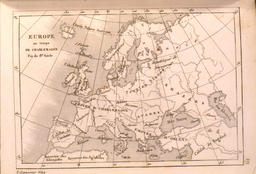
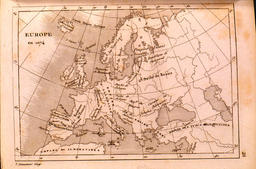
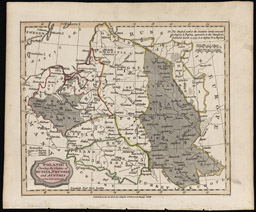
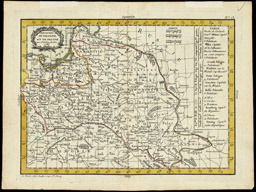
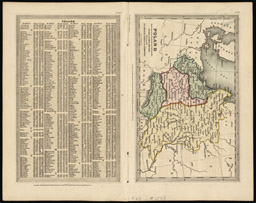



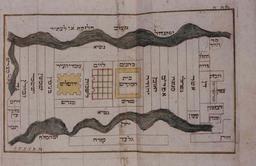
No comments:
Post a Comment